Lichen-Derived Actinomycetota: Novel Taxa and Bioactive Metabolites
Abstract
1. Introduction
2. Novel Actinomycetota Taxa
3. Natural Products from Lichen-Associated Actinomycetota
3.1. N-Containing Compounds
3.1.1. Diketopiperazines
3.1.2. Peptides
3.1.3. Indoles
3.1.4. Pyrrole Derivatives
3.1.5. Pyridine Derivatives
3.1.6. Aromatic Amides and Amines
3.2. Furanones
3.3. Aromatic Compounds
3.3.1. Quinones
3.3.2. Isoflavonoids
3.3.3. Phenolic Derivatives
3.4. Linear Esters and Macrolides
3.5. Sterols
4. Bioactivity of Uncharacterized Compounds
5. Biosynthetic Pathways of Lichen Secondary Metabolites
6. Conclusions
Author Contributions
Funding
Conflicts of Interest
References
- Liu, C.B.; Jiang, Y.; Wang, X.Y.; Chen, D.B.; Chen, X.; Wang, L.S.; Han, L.; Huang, X.S.; Jiang, C.L. Diversity, antimicrobial activity, and biosynthetic potential of cultivable actinomycetes associated with lichen symbiosis. Microb. Ecol. 2017, 74, 570–584. [Google Scholar] [CrossRef] [PubMed]
- Jiang, Y.; Wang, X.Y.; Li, G.D.; Li, Q.Y.; Liu, C.B.; Chen, X.; Wang, L.S.; Yong, L.; Jiang, C.L. Diversity and anti-microbial activities of actinomycetes associated with three species of lichens. Am. J. Biosci. 2015, 3, 171. [Google Scholar] [CrossRef]
- Coley, P.D. Effect of plant-growth rate and leaf lifetime on the amount and type of anti-herbivore defense. Oecologia 1988, 74, 531–536. [Google Scholar] [CrossRef] [PubMed]
- Genilloud, O. Actinomycetes: Still a source of novel antibiotics. Nat. Prod. Rep. 2017, 34, 1203–1232. [Google Scholar] [CrossRef] [PubMed]
- Sigurbjornsdottir, M.A.; Vilhelmsson, O. Selective isolation of potentially phosphate-mobilizing, biosurfactant-producing and biodegradative bacteria associated with a sub-Arctic, terricolous lichen, Peltigera membranacea. Fems Microbiol. Ecol. 2016, 6, 92. [Google Scholar] [CrossRef] [PubMed]
- Ding, T.; Yang, L.J.; Zhang, W.D.; Shen, Y.H. The secondary metabolites of rare actinomycetes: Chemistry and bioactivity. RSC Adv. 2019, 9, 21964–21988. [Google Scholar] [CrossRef]
- Oren, A.; Garrity, G.M. Valid publication of the names of forty- two phyla of prokaryotes. Int. J. Syst. Evol. Microbiol. 2021, 71, 005056. [Google Scholar] [CrossRef]
- Zhang, K.; Jiang, L.Q.; Wang, L.S.; An, D.-F.; Lang, L.; Li, G.D.; Wang, X.Y.; Shi, S.B.; Li, Q.Y.; Jiang, C.L.; et al. Aureimonas leprariae sp. nov. isolated from a Lepraria sp. lichen. Curr. Microbiol. 2020, 77, 313–319. [Google Scholar] [CrossRef]
- Jiang, L.Q.; An, D.F.; Wang, X.Y.; Zhang, K.; Li, G.D.; Lang, L.; Wang, L.S.; Jiang, C.L.; Jiang, Y. Methylobacterium planium sp. nov. isolated from a lichen sample. Arch. Microbiol. 2020, 202, 1709–1715. [Google Scholar] [CrossRef]
- An, D.F.; Jiang, L.Q.; Zhang, K.; Li, G.D.; Wang, X.Y.; Jiang, M.G.; Lang, L.; Wang, L.S.; Imhoff, J.F.; Jiang, C.L.; et al. Glaciibacter flavus sp. nov. isolated from a lichen sample. Arch. Microbiol. 2021, 203, 2439–2444. [Google Scholar] [CrossRef]
- Cardinale, M.; Grube, M.; Berg, G. Frondihabitans cladoniiphilus sp nov. an actinobacterium of the family Microbacteriaceae isolated from lichen, and emended description of the genus Frondihabitans. Int. J. Syst. Evol. Microbiol. 2011, 61, 3033–3038. [Google Scholar] [CrossRef] [PubMed]
- An, S.Y.; Xiao, T.; Yokota, A. Leifsonia lichenia sp nov. isolated from lichen in Japan. J. Gen. Appl. Microbiol. 2009, 55, 339–343. [Google Scholar] [CrossRef] [PubMed]
- Jiang, L.Q.; Zhang, K.; Li, G.D.; Wang, X.Y.; Shi, S.B.; Li, Q.Y.; An, D.F.; Lang, L.; Wang, L.S.; Jiang, C.L.; et al. Naasia lichenicola sp. nov. an actinobacterium isolated from lichen. Int. J. Syst. Evol. Microbiol. 2020, 70, 1026–1030. [Google Scholar] [CrossRef]
- An, S.Y.; Xiao, T.; Yokota, A. Schumannella luteola gen. nov. sp nov. a novel genus of the family Microbacteriaceae. J. Gen. Appl. Microbiol. 2008, 54, 253–258. [Google Scholar] [CrossRef] [PubMed]
- Si, H.L.; Shi, F.X.; Zhang, L.L.; Yue, H.S.; Wang, H.Y.; Zhao, Z.T. Subtercola lobariae sp nov. an actinobacterium of the family Microbacteriaceae isolated from the lichen Lobaria retigera. Int. J. Syst. Evol. Microbiol. 2017, 67, 1516–1521. [Google Scholar] [CrossRef] [PubMed]
- Phongsopitanun, W.; Matsumoto, A.; Inahashi, Y.; Kudo, T.; Mori, M.; Shiomi, K.; Takahashi, Y.; Tanasupawat, S. Actinoplanes lichenis sp nov. isolated from lichen. Int. J. Syst. Evol. Microbiol. 2016, 66, 468–473. [Google Scholar] [CrossRef]
- Saeng-in, P.; Kanchanasin, P.; Yuki, M.; Kudo, T.; Ohkuma, M.; Phongsopitanun, W.; Tanasupawat, S. Actinoplanes lichenicola sp. nov. and Actinoplanes ovalisporus sp. nov. isolated from lichen in Thailand. Int. J. Syst. Evol. Microbiol. 2021, 7, 71. [Google Scholar] [CrossRef]
- Jiang, L.Q.; An, D.F.; Zhang, K.; Li, G.D.; Wang, X.; Lang, L.; Jiang, M.G.; Wang, L.; Jiang, C.L.; Jiang, Y. Nakamurella albus sp. nov.: A novel actinobacterium isolated from a lichen sample. Curr. Microbiol. 2020, 77, 1896–1901. [Google Scholar] [CrossRef]
- An, D.F.; Yang, S.J.; Jiang, L.Q.; Wang, X.Y.; Huang, X.Y.; Lang, L.; Chen, X.M.; Fan, M.Q.; Li, G.D.; Jiang, M.G.; et al. Nakamurella leprariae sp. nov. isolated from a lichen sample. Arch. Microbiol. 2022, 19, 204. [Google Scholar] [CrossRef]
- Li, B.; Xie, C.H.; Yokota, A. Nocardioides exalbidus sp. nov. a novel actinomycete isolated from lichen in Izu-Oshima Island, Japan. Actinomycetologica 2007, 21, 22–26. [Google Scholar] [CrossRef]
- Hamada, M.; Yamamura, H.; Komukai, C.; Tamura, T.; Suzuki, K.-i.; Hayakawa, M. Luteimicrobium album sp nov. a novel actinobacterium isolated from a lichen collected in Japan, and emended description of the genus Luteimicrobium. J. Antibiot. 2012, 65, 427–431. [Google Scholar] [CrossRef] [PubMed]
- Yamamura, H.; Ashizawa, H.; Nakagawa, Y.; Hamada, M.; Ishida, Y.; Otoguro, M.; Tamura, T.; Hayakawa, M. Actinomycetospora iriomotensis sp nov. a novel actinomycete isolated from a lichen sample. J. Antibiot. 2011, 64, 289–292. [Google Scholar] [CrossRef] [PubMed]
- Yamamura, H.; Ashizawa, H.; Nakagawa, Y.; Hamada, M.; Ishida, Y.; Otoguro, M.; Tamura, T.; Hayakawa, M. Actinomycetospora rishiriensis sp nov. isolated from a lichen. Int. J. Syst. Evol. Microbiol. 2011, 61, 2621–2625. [Google Scholar] [CrossRef] [PubMed]
- Vobis, G.; Solans, M.; Scervino, J.M.; Schumann, P.; Sproeer, C.; Messuti, M.I. Isolation and characterization of an endolichenic actinobacterium from the lichen thallus of Pseudocyphellaria berberina. Symbiosis 2020, 80, 43–51. [Google Scholar] [CrossRef]
- Lang, L.; An, D.F.; Jiang, L.Q.; Li, G.D.; Wang, L.S.; Wang, X.Y.; Li, Q.Y.; Jiang, C.L.; Jiang, Y. Paracoccus lichenicola sp. nov. Isolated from Lichen. Curr. Microbiol. 2021, 78, 816–821. [Google Scholar] [CrossRef]
- Jiang, L.Q.; Zhang, K.; Li, G.D.; Wang, X.Y.; Shi, S.B.; Li, Q.Y.; An, D.F.; Lang, L.; Wang, L.S.; Jiang, C.L.; et al. Rubellimicrobium rubrum sp. nov. a novel bright reddish bacterium isolated from a lichen sample. Antonie Van Leeuwenhoek Int. J. Gen. Mol. Microbiol. 2019, 112, 1739–1745. [Google Scholar] [CrossRef]
- Saeng-In, P.; Phongsopitanun, W.; Savarajara, A.; Tanasupawat, S. Streptomyces lichenis sp nov. isolated from lichen. Int. J. Syst. Evol. Microbiol. 2018, 68, 3641–3646. [Google Scholar] [CrossRef]
- Schneider, O.; Simic, N.; Aachmann, F.L.; Rueckert, C.; Kristiansen, K.A.; Kalinowski, J.; Jiang, Y.; Wang, L.; Jiang, C.-L.; Lale, R.; et al. Genome mining of Streptomyces sp. YIM 130001 isolated from lichen affords new thiopeptide antibiotic. Front. Microbiol. 2018, 9, 3139. [Google Scholar] [CrossRef]
- Somphong, A.; Poengsungnoen, V.; Buaruang, K.; Suriyachadkun, C.; Sripreechasak, P.; Tanasupawat, S.; Phongsopitanun, W. Diversity of the culturable lichen-derived actinobacteria and the taxonomy of Streptomyces parmotrematis sp. nov. Antonie Van Leeuwenhoek. Int. J. Gen. Mol. Microbiol. 2022, 115, 911–920. [Google Scholar] [CrossRef]
- Kanchanasin, P.; Phongsopitanun, W.; Yuki, M.; Kudo, T.; Ohkuma, M.; Nakashima, T.; Tanasupawat, S. Actinomadura violacea sp. nov. a madurastatin A1-producing strain isolated from lichen in Thailand. Int. J. Syst. Evol. Microbiol. 2021, 12, 71. [Google Scholar] [CrossRef]
- Somphong, A.; Poengsungnoen, V.; Buaruang, K.; Suriyachadkun, C.; Sripreechasak, P.; Tanasupawat, S.; Phongsopitanun, W. Actinomadura parmotrematis sp. nov. isolated from the foliose lichen, Parmotrema praesorediosum (Nyl.) Hale. Int. J. Syst. Evol. Microbiol. 2022, 7, 72. [Google Scholar] [CrossRef] [PubMed]
- Song, Z.Q.; Hou, Y.G.; Yang, Q.R.; Li, X.P.; Wu, S.H. Structures and biological activities of diketopiperazines from marine organisms: A review. Mar. Drugs 2021, 19, 403. [Google Scholar] [CrossRef] [PubMed]
- Liu, C.S.; Jiang, Y.; Huang, R.; Jiang, B.G.; Zheng, K.X.; Wu, S.H. Diverse secondary metabolites from a lichen-derived Amycolatopsis Strain. Curr. Microbiol. 2020, 77, 2104–2110. [Google Scholar] [CrossRef]
- Noel, A.; Ferron, S.; Rouaud, I.; Gouault, N.; Hurvois, J.P.; Tomasi, S. Isolation and structure identification of novel brominated diketopiperazines from Nocardia ignorata a lichen-associated actinobacterium. Molecules 2017, 22, 371. [Google Scholar] [CrossRef] [PubMed]
- Jiang, B.G.; Wei, H.X.; Wang, Y.T.; Zheng, K.X.; Liu, S.S.; Zhang, S.P.; Jiang, Y.; Wu, S.H. Secondary metabolites of two lichen-derived Streptomyces. Chem. Nat. Compd. 2019, 55, 783–786. [Google Scholar] [CrossRef]
- Parrot, D.; Legrave, N.; Intertaglia, L.; Rouaud, I.; Legembre, P.; Grube, M.; Suzuki, M.T.; Tomasi, S. Cyaneodimycin, a bioactive compound isolated from the culture of Streptomyces cyaneofuscatus associated with Lichina confinis. Eur. J. Org. Chem. 2016, 2016, 3977–3982. [Google Scholar] [CrossRef]
- Hei, Y.Y.; Zhang, H.L.; Tan, N.N.; Zhou, Y.H.; Wei, X.; Hu, C.H.; Liu, Y.D.; Wang, L.; Qi, J.Z.; Gao, J.M. Antimicrobial activity and biosynthetic potential of cultivable actinomycetes associated with lichen symbiosis from Qinghai-Tibet Plateau. Microbiol. Res. 2021, 244, 126652. [Google Scholar] [CrossRef]
- Maini, R.; Umemoto, S.; Suga, H. Ribosome-mediated synthesis of natural product-like peptides via cell-free translation. Curr. Opin. Chem. Biol. 2016, 34, 44–52. [Google Scholar] [CrossRef]
- Aguda, A.H.; Lavallee, V.; Cheng, P.; Bott, T.M.; Meimetis, L.G.; Law, S.; Nguyen, N.T.; Williams, D.E.; Kaleta, J.; Villanueva, I.; et al. Affinity crystallography: A new approach to extracting high-affinity enzyme inhibitors from natural extracts. J. Nat. Prod. 2016, 79, 1962–1970. [Google Scholar] [CrossRef]
- Bracegirdle, J.; Hou, P.; Nowak, V.V.; Ackerley, D.F.; Keyzers, R.A.; Owen, J.G. Skyllamycins D and E, non-ribosomal cyclic depsipeptides from lichen-sourced Streptomyces anulatus. J. Nat. Prod. 2021, 84, 2536–2543. [Google Scholar] [CrossRef]
- Mahmoud, E.; Hayallah, A.M.; Kovacic, S.; Abdelhamid, D.; Abdel-Aziz, M. Recent progress in biologically active indole hybrids: A mini review. Pharmacol. Rep. 2022, 74, 570–582. [Google Scholar] [CrossRef] [PubMed]
- Williams, D.E.; Davies, J.; Patrick, B.O.; Bottriell, H.; Tarling, T.; Roberge, M.; Andersen, R.J. Cladoniamides A-G, tryptophan-derived alkaloids produced in culture by Streptomyces uncialis. Org. Lett. 2008, 10, 3501–3504. [Google Scholar] [CrossRef] [PubMed]
- Rostami, H.; Shiri, L. Review on synthesis of pyrrole derivatives promoted by nanoparticles. Appl. Organomet. Chem. 2021, 35, 6209. [Google Scholar] [CrossRef]
- Miyakoshi, T.; Konno, H. Improved synthesis of 2,4,6-trialkylpyridines from 1,5-diketoalkanes: The total synthesis of anibamine. Org. Biomol. Chem. 2019, 17, 2896–2905. [Google Scholar] [CrossRef]
- Jin, Y.; Aobulikasimu, N.; Zhang, Z.; Liu, C.; Cao, B.; Lin, B.; Guan, P.; Mu, Y.; Jiang, Y.; Han, L.; et al. Amycolasporins and dibenzoyls from lichen-associated Amycolatopsis hippodromi and their antibacterial and anti-inflammatory Activities. J. Nat. Prod. 2020, 83, 3545–3553. [Google Scholar] [CrossRef] [PubMed]
- Kawahara, T.; Hosoya, T.; Tsukamoto, M.; Okabe, S.; Yamamura, H.; Hayakawa, M.; Seimiya, H.; Takagi, M.; Shin-ya, K. JBIR-120: A new growth inhibitor of hormone-refractory prostate cancer cells. J. Antibiot. 2012, 65, 373–375. [Google Scholar] [CrossRef]
- Neu, D.; Lehmann, T.; Elleuche, S.; Pollmann, S. Arabidopsis amidase 1, a member of the amidase signature family. FEBS J. 2007, 274, 3440–3451. [Google Scholar] [CrossRef]
- Su, S.S.; Tian, L.; Chen, G.; Li, Z.Q.; Xu, W.F.; Pei, Y.H. Two new compounds from the metabolites of a marine-derived actinomycete Streptomyces cavourensis YY01-17. J. Asian Nat. Prod. Res. 2013, 15, 265–269. [Google Scholar] [CrossRef]
- Zheng, K.X.; Jiang, Y.; Jiang, J.X.; Huang, R.; He, J.; Wu, S.H. A new phthalazinone derivative and a new isoflavonoid glycoside from lichen-associated Amycolatopsis sp. Fitoterapia 2019, 135, 85–89. [Google Scholar] [CrossRef]
- Xu, T.C.; Song, Z.Q.; Hou, Y.G.; Liu, S.S.; Li, X.P.; Yang, Q.R.; Wu, S.H. Secondary metabolites of the genus Nigrospora from terrestrial and marine habitats: Chemical diversity and biological activity. Fitoterapia 2022, 161, 105254. [Google Scholar] [CrossRef]
- Motohashi, K.; Takagi, M.; Yamamura, H.; Hayakawa, M.; Shin-Ya, K. A new angucycline and a new butenolide isolated from lichen-derived Streptomyces spp. J. Antibiot. 2010, 63, 545–548. [Google Scholar] [CrossRef] [PubMed]
- Ma, J.; Cao, B.X.; Liu, C.B.; Guan, P.P.; Mu, Y.; Jiang, Y.; Han, L.; Huang, X.S. Actinofuranones D-I from a lichen-associated actinomycetes, Streptomyces gramineus, and their anti-inflammatory effects. Molecules 2018, 23, 2393. [Google Scholar] [CrossRef] [PubMed]
- Eyong, K.O.; Kuete, V.; Efferth, T. Quinones and benzophenones from the medicinal plants of Africa. Med. Plant Res. Afr. 2013, 10, 351–391. [Google Scholar]
- Liu, C.B.; Jiang, Y.; Lei, H.; Chen, X.; Ma, Q.J.; Han, L.; Huang, X.S. Four new nanaomycins produced by Streptomyces hebeiensis derived from Lichen. Chem. Biodivers. 2017, 14, 170057. [Google Scholar] [CrossRef] [PubMed]
- Kojiri, K.; Nakajima, S.; Fuse, A.; Suzuki, H.; Suda, H. BE-24566B, a new antibiotic Produced by Streptomyces violaceusniger. J. Antibiot. 1995, 48, 1506–1508. [Google Scholar] [CrossRef] [PubMed]
- Liu, C.Y.; Li, Y.L.; Lu, J.H.; Qian, L.L.; Xu, K.; Wang, N.N.; Chang, W.Q.; Lou, H.X. Steffimycin F, a new steffimycin-type derivative from the lichen-derived actinomycetes streptomyces sp. J. Mol. Struct. 2021, 5, 1227. [Google Scholar]
- Davies, J.; Wang, H.; Taylor, T.; Warabi, K.; Huang, X.H.; Andersen, R.J. Uncialamycin, a new enediyne antibiotic. Org. Lett. 2005, 7, 5233–5236. [Google Scholar] [CrossRef]
- Al-Maharik, N. Isolation of naturally occurring novel isoflavonoids: An update. Nat. Prod. Rep. 2019, 36, 1156–1195. [Google Scholar] [CrossRef]
- Acosta-Estrada, B.A.; Gutierrez-Uribe, J.A.; Serna-Saldivar, S.O. Bound phenolics in foods, a review. Food Chem. 2014, 152, 46–55. [Google Scholar] [CrossRef]
- Singh, B.; Singh, J.P.; Kaur, A.; Singh, N. Phenolic composition and antioxidant potential of grain legume seeds: A review. Food Res. Int. 2017, 101, 1–16. [Google Scholar] [CrossRef]
- Sharma, N.; Thakre, G.D.; Ray, A. Hitherto unexplored three-membered heterocyclic rings favorably alter tribological properties of fatty acid linear esters. Tribol. Trans. 2021, 64, 996–1021. [Google Scholar] [CrossRef]
- Lambu, M.R.; Dash, A.K.; Hussain, N.; Bhat, S.; Raina, S.; Mukherjee, D. Synthesis of macrolide natural products from carbohydrates. Trends Carbohydr. Res. 2017, 9, 1–13. [Google Scholar]
- Valitova, J.N.; Sulkarnayeva, A.G.; Minibayeva, F.V. Plant sterols: Diversity, biosynthesis, and physiological functions. Biochem. -Mosc. 2016, 81, 819–834. [Google Scholar] [CrossRef]
- Rangseekaew, P.; Pathom-aree, W. Cave actinobacteria as producers of bioactive metabolites. Front. Microbiol. 2019, 10, 387. [Google Scholar] [CrossRef]
- Saeng-in, P.; Kuncharoen, N.; Chamroensaksri, N.; Tanasupawat, S. Identification and antimicrobial activity of Streptomyces and Actinoplanes strains from lichens. J. Appl. Pharm. Sci. 2015, 5, 23–29. [Google Scholar]
- Susanti, A.E.; Ratnakomala, S.; Mangunwardoyo, W.; Lisdiyanti, P.; Assoc Comp, M. In antimicrobialactivity of lichens-associated Actinomycetes Strain LC-23. Assoc. Comput. Mach. 2019, 19, 9–96. [Google Scholar]
- Rajaram, S.K.; Ahmad, P.; Keerthana, S.S.S.; Cressida, P.J.; Moorthy, I.G.; Suresh, R.S.S. Extraction and purification of an antimicrobial bioactive element from lichen associated Streptomyces olivaceus LEP7 against wound inhabiting microbial pathogens. J. King Saud Univ. Sci. 2020, 32, 2009–2015. [Google Scholar] [CrossRef]
- Lee, K.A.; Kim, M.S. Glucosidase inhibitor from Umbilicaria esculenta. Can. J. Microbiol. 2000, 46, 1077–1081. [Google Scholar] [CrossRef]
- Cunha, M.N.C.; Silva, N.M.V.; Teixeira, M.F.S.; Mota, R.A.; Lima, J.L.; Porto, T.S.; Porto, A.L.F. Actinomycetes producers of beta-lactamases inhibitors with antimicrobial activity against microorganisms isolated from bovine mastitis. Arq. Bras. Med. Vet. E Zootec. 2010, 62, 1312–1319. [Google Scholar] [CrossRef]
- Silva, G.M.M.; Bezerra, R.P.; Teixeira, J.A.; Porto, T.S.; Lima, J.L.; Porto, A.L.F. Fibrinolytic protease production by new Streptomyces sp. DPUA 1576 from Amazon lichens. Electron. J. Biotechnol. 2015, 18, 16–19. [Google Scholar] [CrossRef]
- Silva, G.M.M.; Bezerra, R.P.; Teixeira, J.A.; Silva, F.O.; Correia, J.M.; Porto, T.S.; Lima-Filho, J.L.; Porto, A.L.F. Screening, production and biochemical characterization of a new fibrinolytic enzyme produced by Streptomyces sp. (Streptomycetaceae) isolated from Amazonian lichens. Acta Amaz. 2016, 46, 323–331. [Google Scholar] [CrossRef]
- Huo, L.; Hug, J.J.; Fu, C.; Bian, X.; Zhang, Y.; Mueller, R. Heterologous expression of bacterial natural product biosynthetic pathways. Nat. Prod. Rep. 2019, 36, 1412–1436. [Google Scholar] [CrossRef]
- Cravens, A.; Payne, J.; Smolke, C.D. Synthetic biology strategies for microbial biosynthesis of plant natural products. Nat. Commun. 2019, 10, 2142. [Google Scholar] [CrossRef]
- Ryan, K.S. Biosynthetic gene cluster for the cladoniamides, bis-indoles with a rearranged scaffold. PLoS ONE 2011, 6, 23694. [Google Scholar] [CrossRef]
- Song, Z.Q.; Xu, T.C.; Wang, J.F.; Hou, Y.G.; Liu, C.S.; Liu, S.S.; Wu, S.H. Secondary metabolites of the genus Amycolatopsis: Structures, bioactivities and biosynthesis. Molecules 2021, 26, 1884. [Google Scholar] [CrossRef]

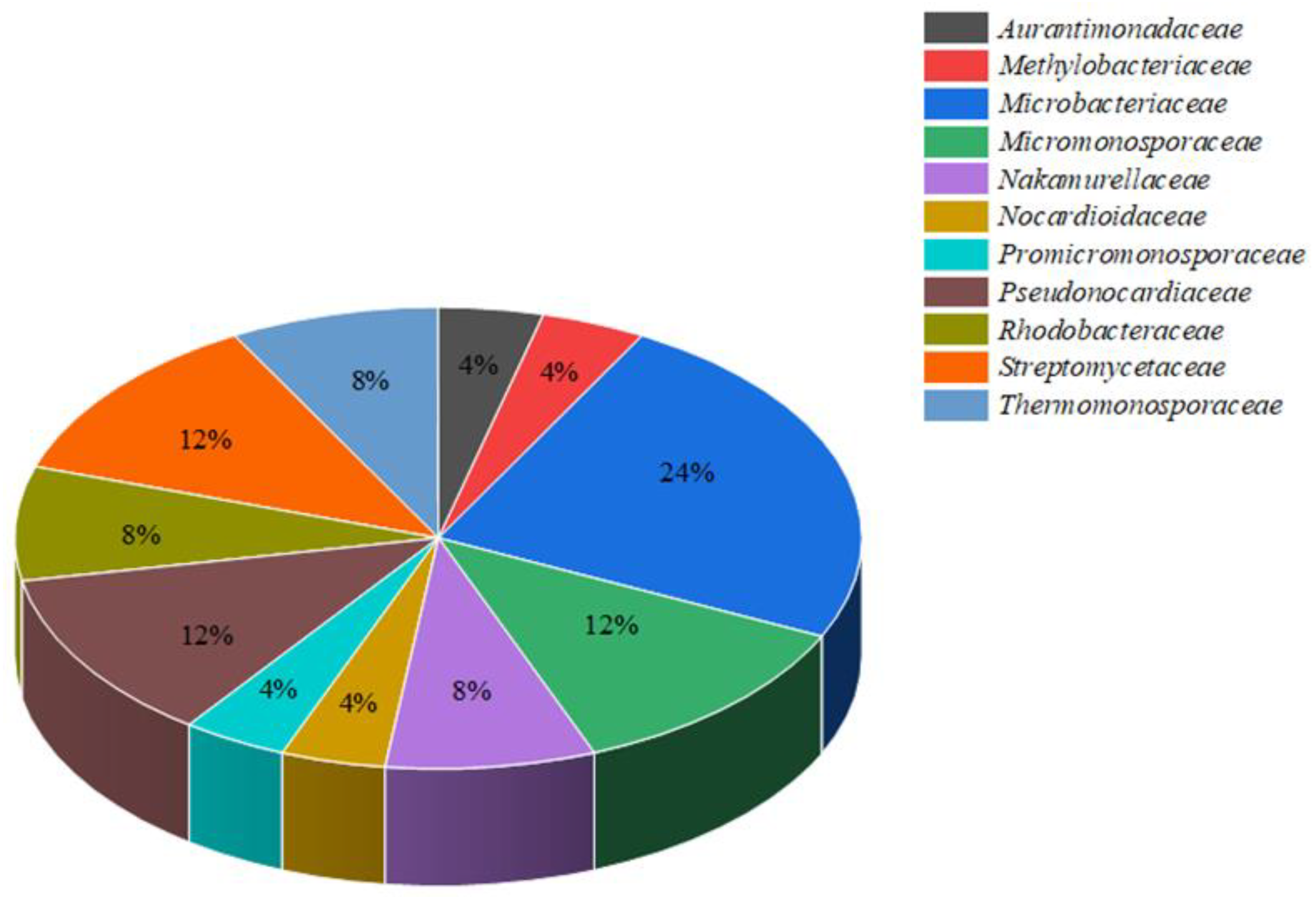
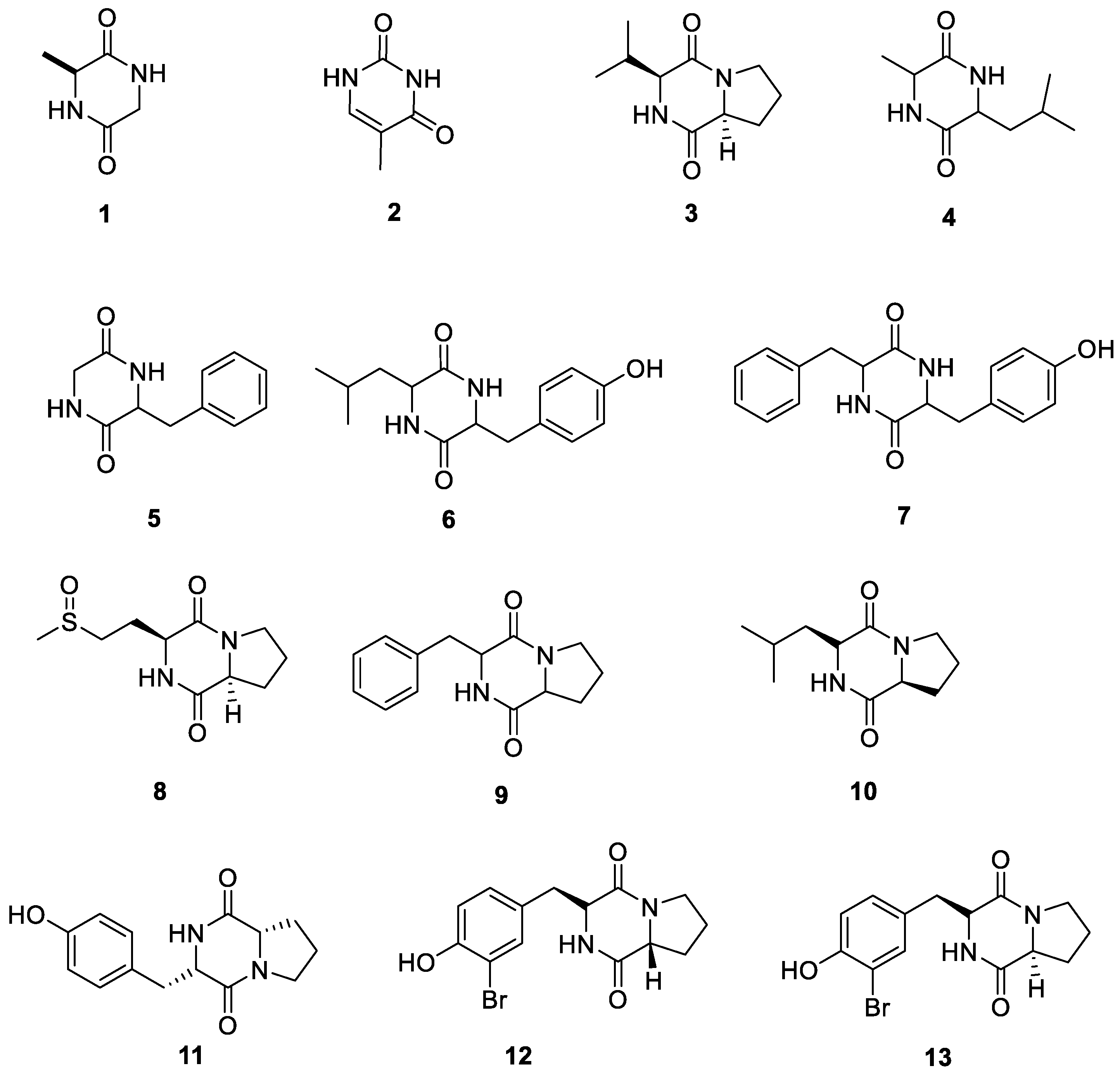
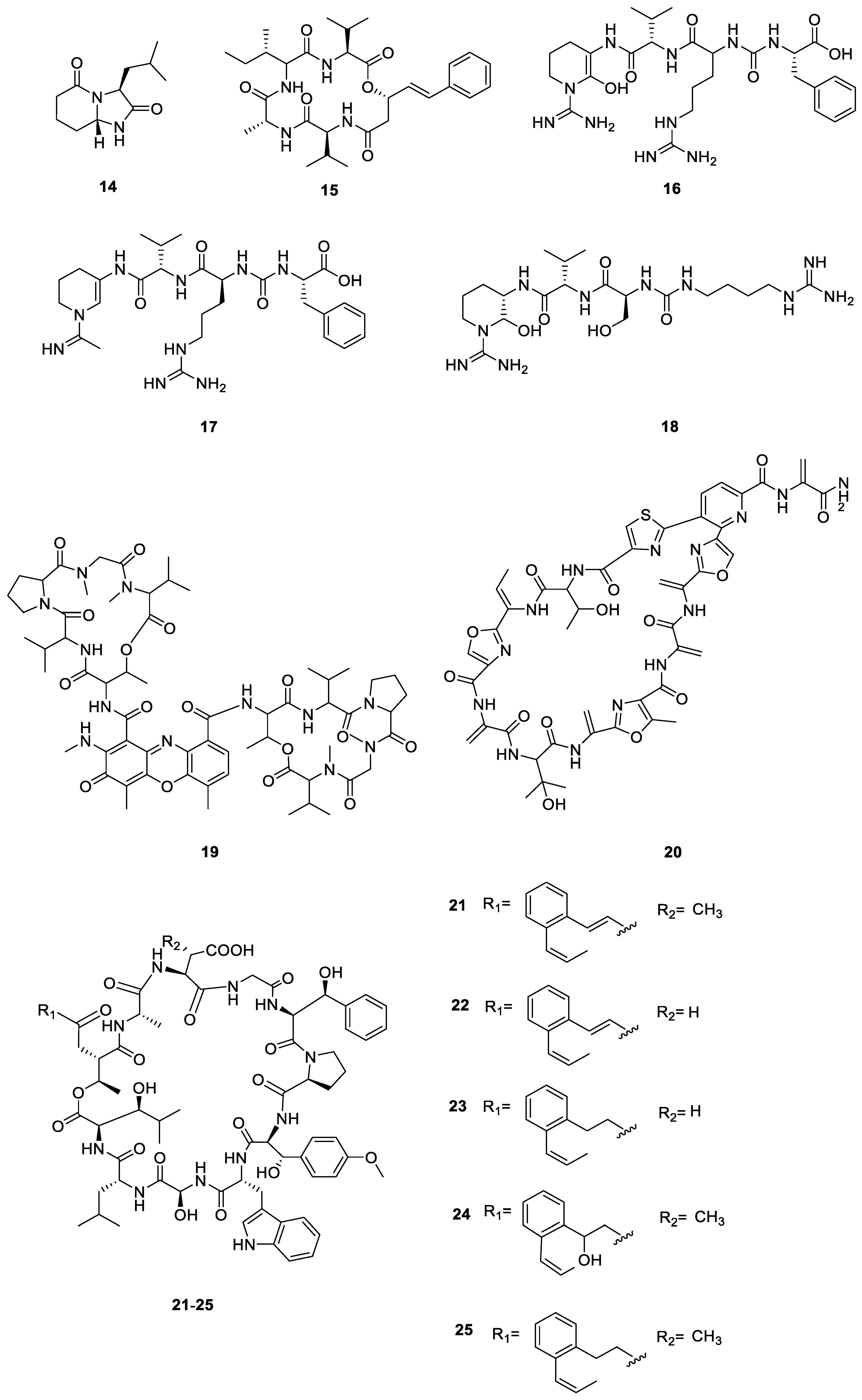
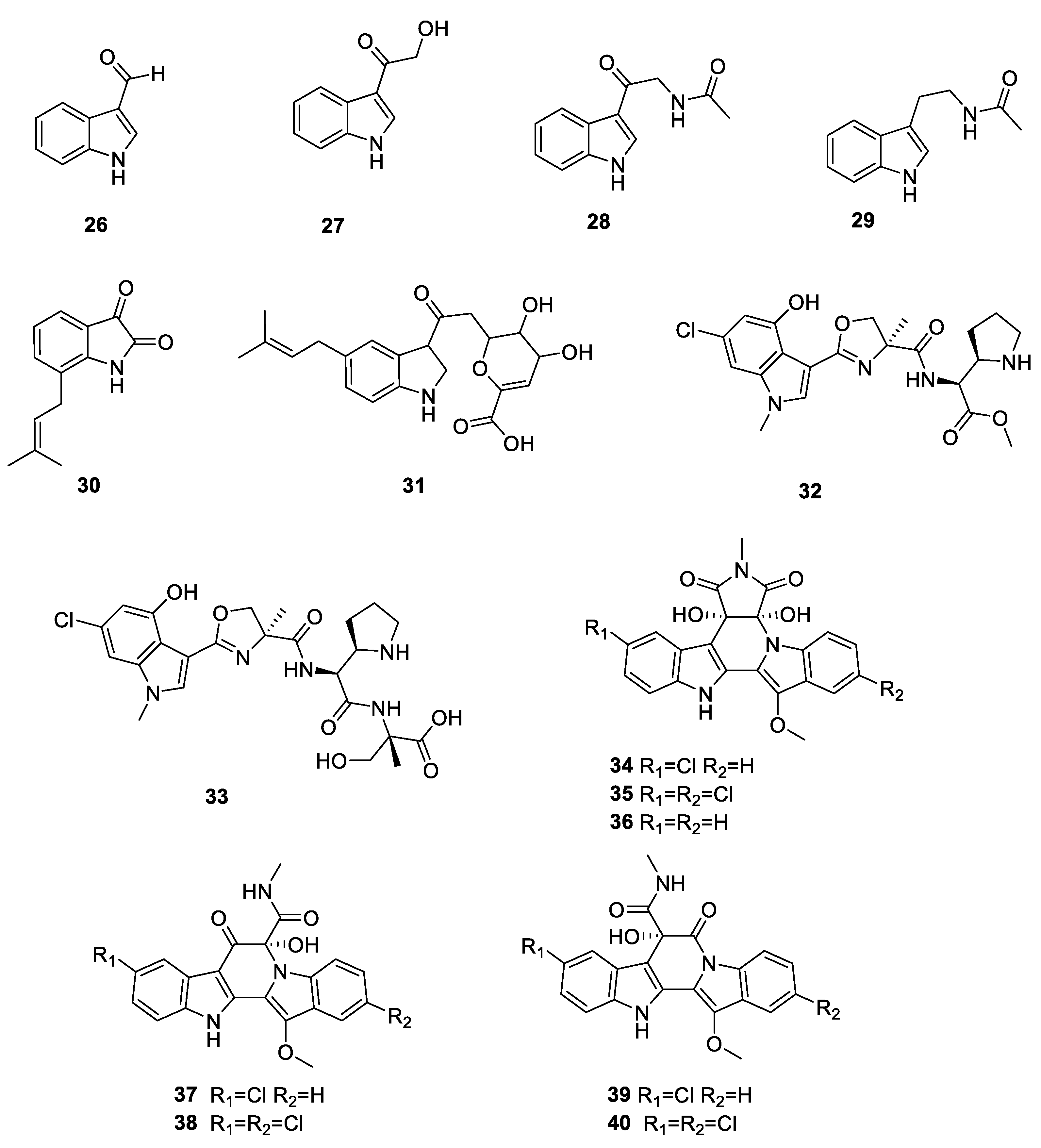


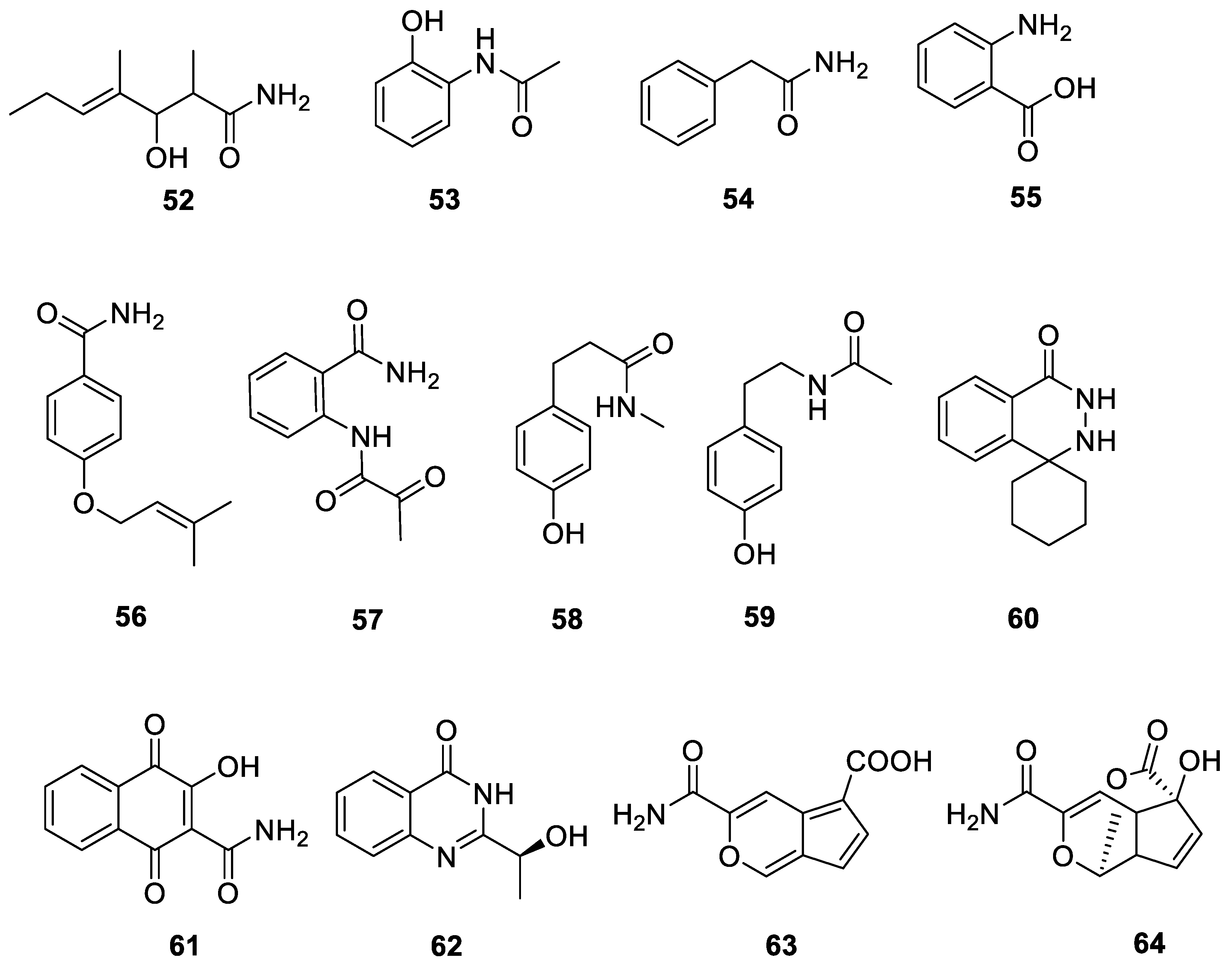
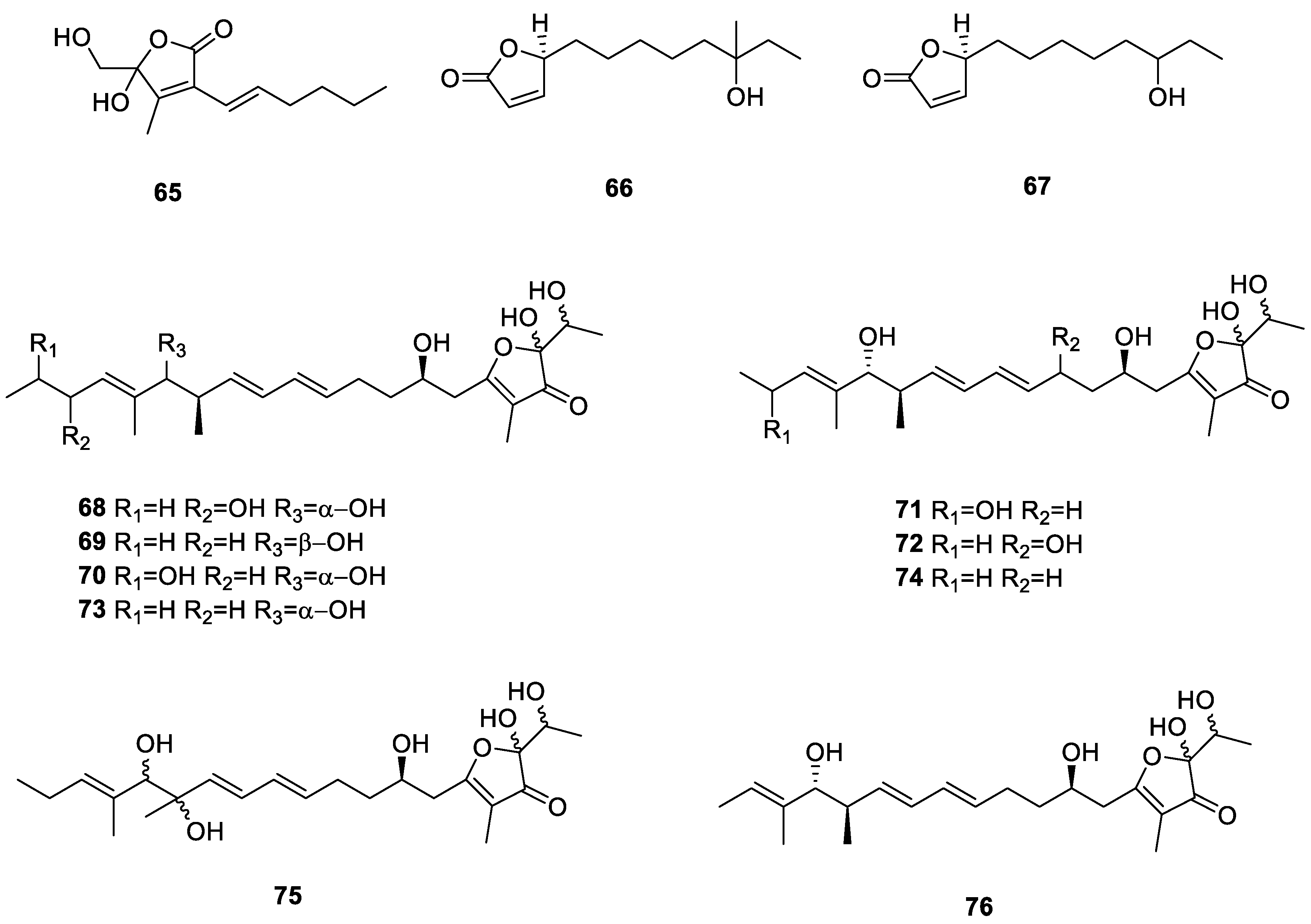
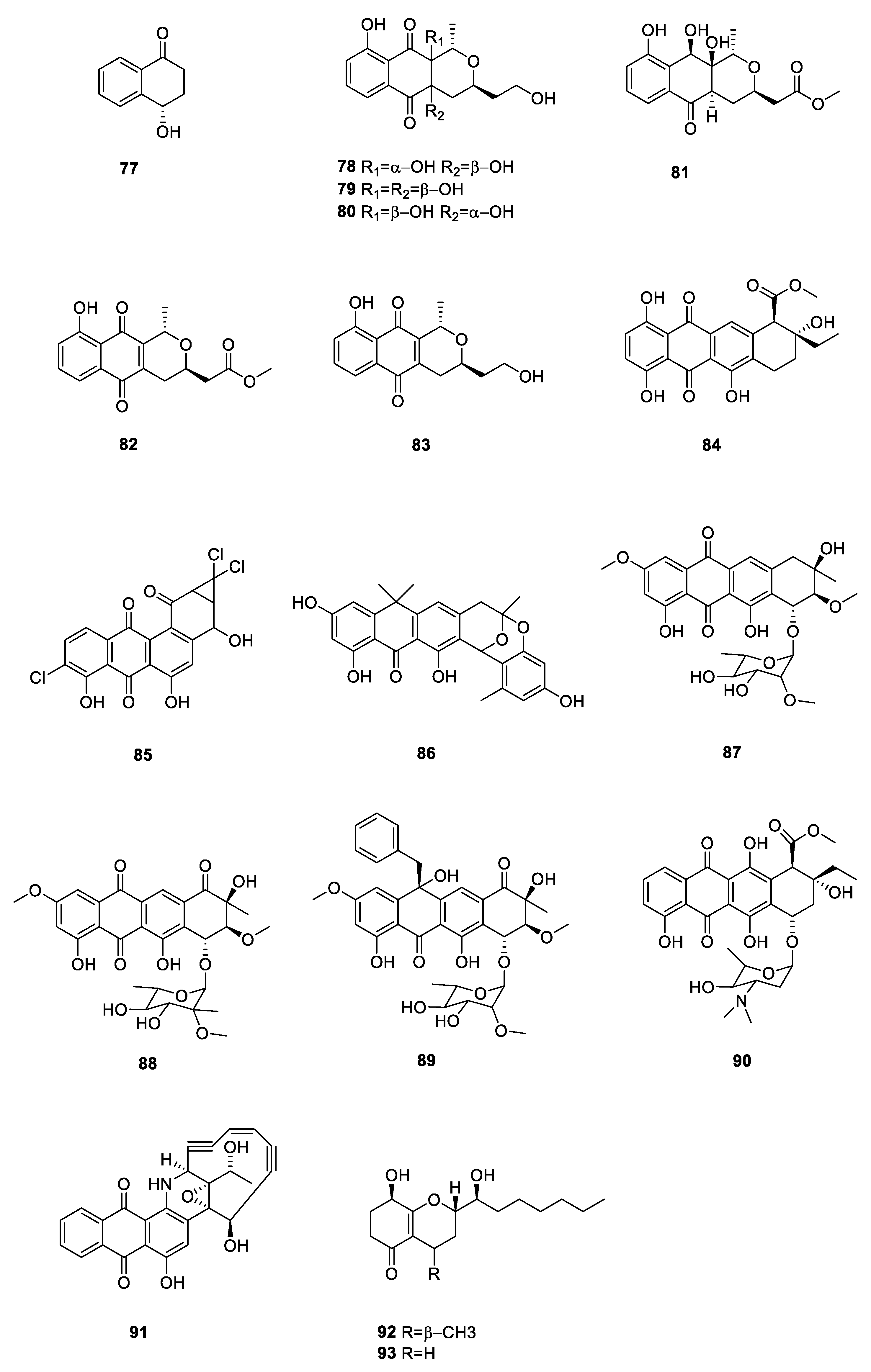


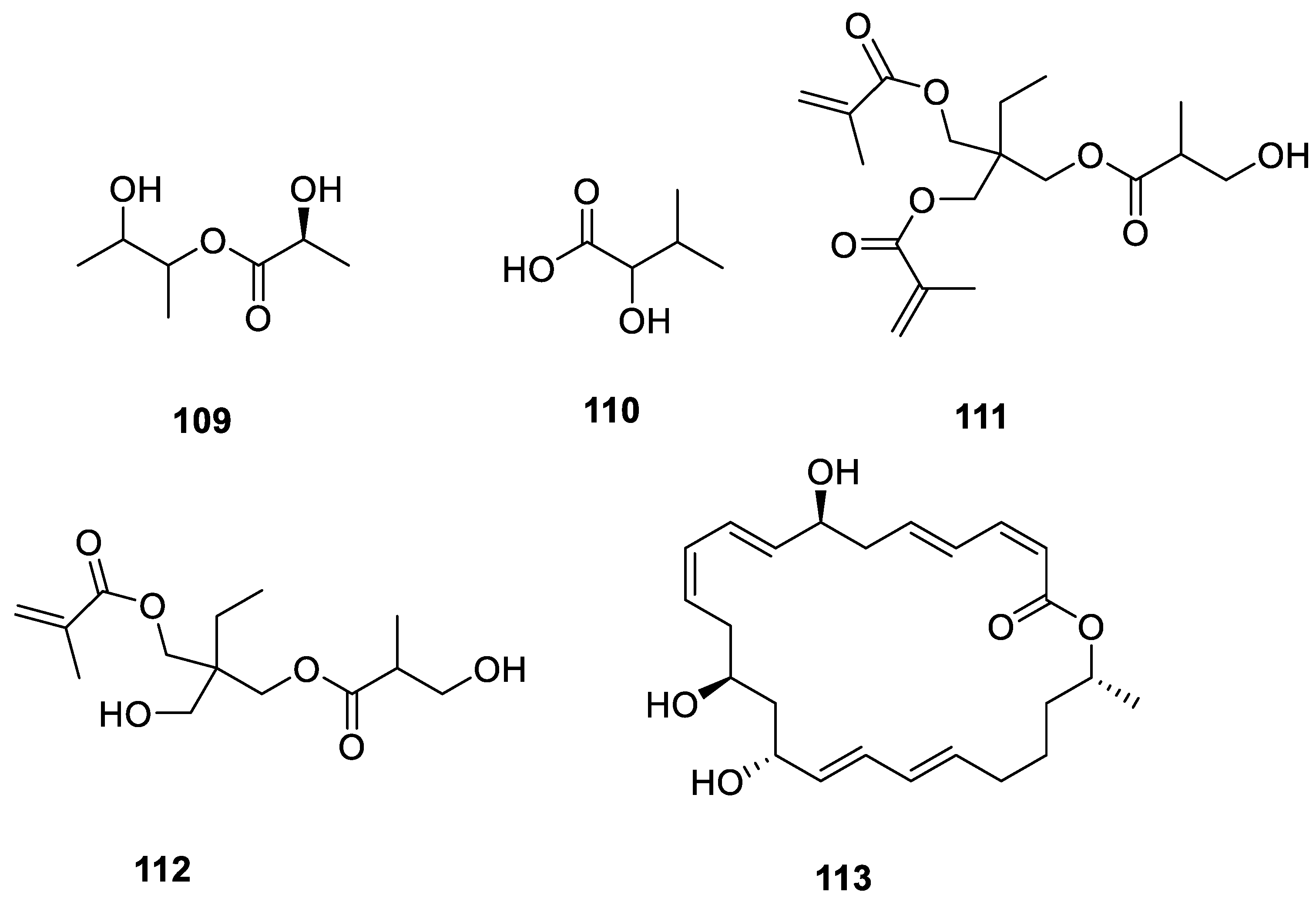
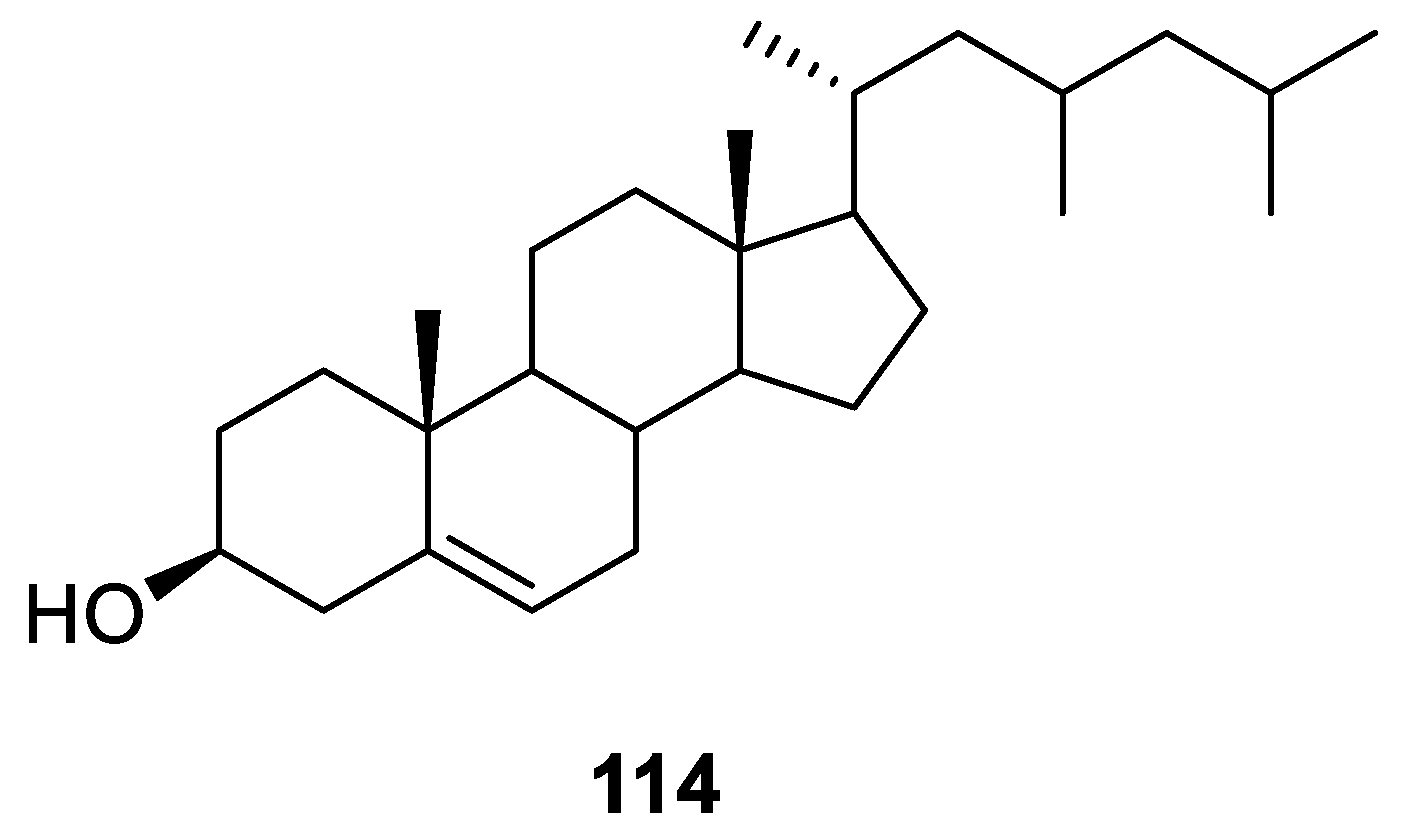
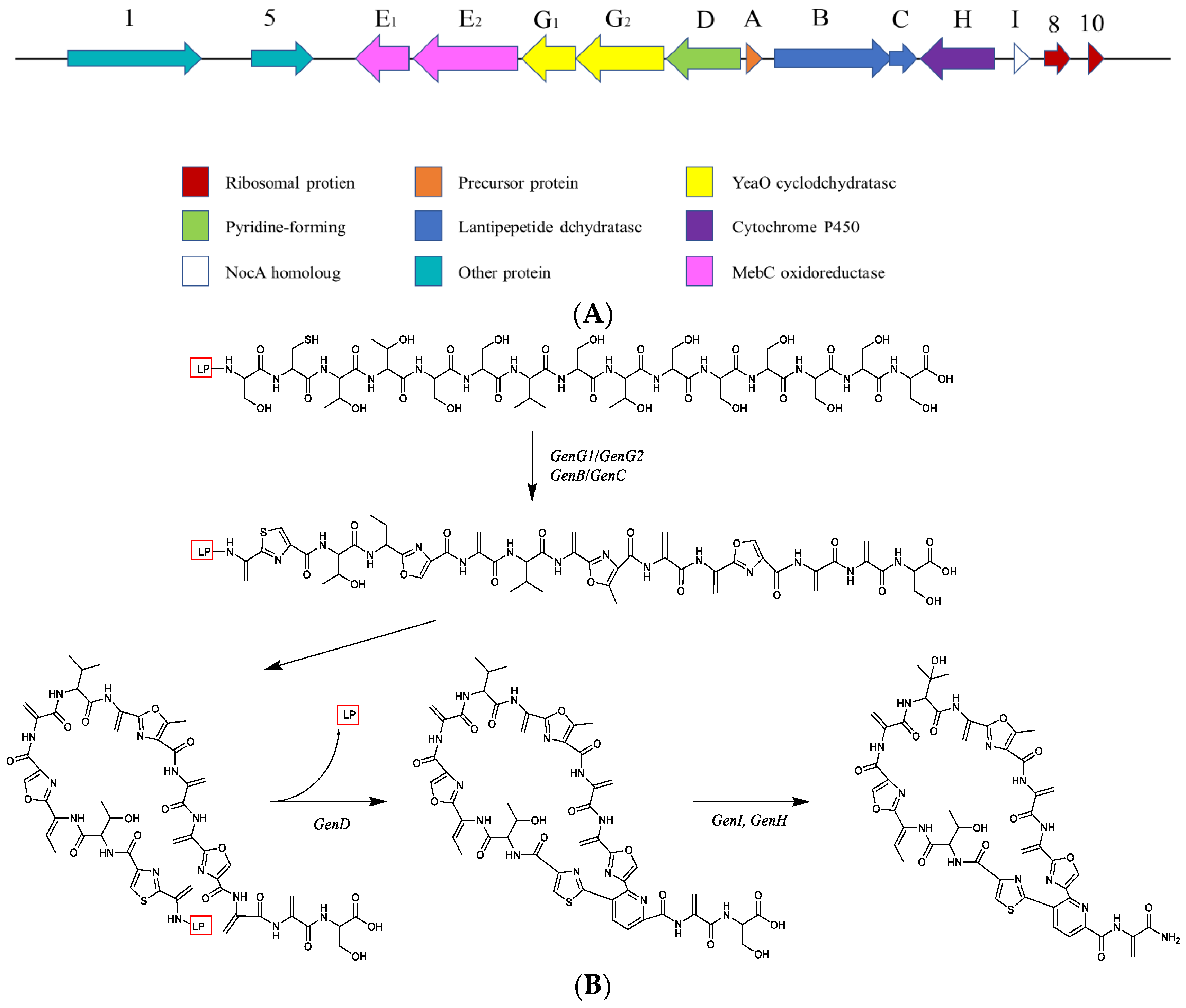
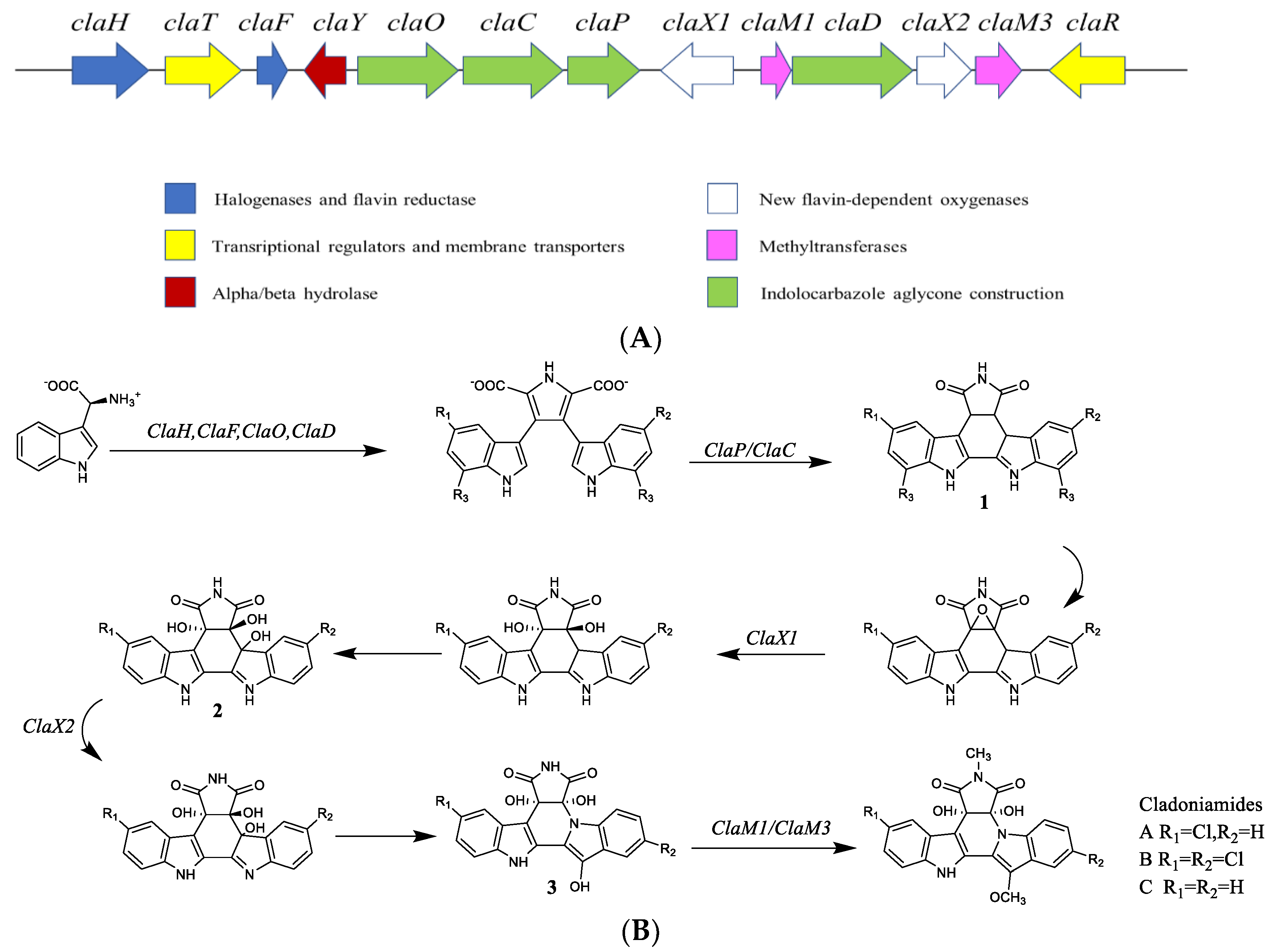
| Family | Genus | Species | Lichen Habitats | Media | Refs. |
|---|---|---|---|---|---|
| Aurantimonadaceae | Aureimonas | Aureimona leprariae | Yunnan Province, south-west PR China | Humic acid–vitamin agar and ISP2 | [8] |
| Methylobacteriaceae | Methylobacterium | Methylobacterium planium | Yunnan Province, south-west PR China | Humic acid–vitamin agar | [9] |
| Microbacteriaceae | Glaciibacter | Glaciibacter flavus | The south bank forest of the Baltic Sea, Germany | Humic acid–vitamin agar | [10] |
| Frondihabitans | Frondihabitans cladoniiphilus | The natural spruce forest at Koralpe, in the Austrian Alps | Tryptone–yeast extract medium and ISP2 | [11] | |
| Leifsonia | Leifsonia lichenia | The Botanical Garden of the University of Tokyo | Modified Detmer medium and nutrient agar | [12] | |
| Naasia | Naasia lichenicola | The south bank of the Baltic Sea, Germany | Humic acid–vitamin agar and YIM 38 medium | [13] | |
| Schumannella | Schumannella luteola | Tokyo, Japan | Modified Detmer medium and nutrient agar | [14] | |
| Subtercola | Subtercola lobariae | Jiaozi Snow Mountain, Yunnan Province, China | Potato dextrose agar and ISP2 | [15] | |
| Micromonosporaceae | Actinoplanes | Actinoplanes lichenis | Maha Sarakham Province, Thailand | Humic acid–vitamin agar with nalidixic acid and cycloheximide and ISP2 | [16] |
| Actinoplanes lichenicola | Maha Sarakham Province, Thailand | Humic acid–vitamin agar with nalidixic acid and cycloheximide and ISP2 | [17] | ||
| Actinoplanes ovalisporus | Maha Sarakham Province, Thailand | Humic acid–vitamin agar with nalidixic acid and cycloheximide and ISP2 | [17] | ||
| Nakamurellaceae | Nakamurella | Nakamurella albus | Yunnan Province, south-west PR China | Humic acid–vitamin agar and ISP2 | [18] |
| Nakamurella | Nakamurella leprariae | Yunnan Province, south-west PR China | Humic acid–vitamin agar and YIM 38 medium | [19] | |
| Nocardioidaceae | Nocardioides | Nocardioides exalbidus | Izu-Oshima Island, Japan | IAM-A1 agar medium and trypticase soy agar | [20] |
| Promicromonosporaceae | Luteimicrobium | Luteimicrobium album | Rishiri Island, Japan | Humic acid–vitamin agar with nalidixic acid and cycloheximide and nutrient agar | [21] |
| Pseudonocardiaceae | Actinomycetospora | Actinomycetospora iriomotensis | Iriomote Island, Japan. | Humic acid–vitamin agar with nalidixic acid and cycloheximide and nutrient agar | [22] |
| Actinomycetospora rishiriensis | Rishiri Island, Hokkaido, Japan. | Humic acid–vitamin agar with nalidixic acid and cycloheximide | [23] | ||
| Pseudonocardia | Pseudonocardia | Nahuel Huapi National Park, Patagonia | Artificial soil agar and Emerson’s yeast extract–starch agar and KEHE agar | [24] | |
| Rhodobacteraceae | Paracoccus | Paracoccus lichenicola | Yunnan Province, south-west PR China | Humic acid–vitamin agar and YIM 38 medium | [25] |
| Rubellimicrobium | Rubellimicrobium rubrum | The south bank forest of the Baltic Sea, Germany | Humic acid–vitamin agar and YIM 38 medium | [26] | |
| Streptomycetaceae | Streptomyces | Streptomyces lichenis | Chiang Rai Province, Thailand | Arginine–vitamin agar and ISP2 | [27] |
| Streptomyces | The tropical rainforest in Xishuangbanna, Yunnan, China | YIM 212 medium | [28] | ||
| Streptomyces parmotrematis | Doi Suthep-Pui National Park, Chiang Mai Province, Thailand. | Humic acid–vitamin agar and starch casein nitrate agar with cycloheximide and nalidixic acid | [29] | ||
| Thermomonosporaceae | Actinomadura | Actinomadura violacea | Pong Phra Bat Waterfall, Chiang Rai Province, Thailand | Humic acid–vitamin agar with nalidixic acid and cycloheximide | [30] |
| Actinomadura parmotrematis | Chiang Rai Province, Thailand | Starch–casein nitrate agar with nalidixic acid and cycloheximide | [31] |
Disclaimer/Publisher’s Note: The statements, opinions and data contained in all publications are solely those of the individual author(s) and contributor(s) and not of MDPI and/or the editor(s). MDPI and/or the editor(s) disclaim responsibility for any injury to people or property resulting from any ideas, methods, instructions or products referred to in the content. |
© 2023 by the authors. Licensee MDPI, Basel, Switzerland. This article is an open access article distributed under the terms and conditions of the Creative Commons Attribution (CC BY) license (https://creativecommons.org/licenses/by/4.0/).
Share and Cite
Yang, Q.; Song, Z.; Li, X.; Hou, Y.; Xu, T.; Wu, S. Lichen-Derived Actinomycetota: Novel Taxa and Bioactive Metabolites. Int. J. Mol. Sci. 2023, 24, 7341. https://doi.org/10.3390/ijms24087341
Yang Q, Song Z, Li X, Hou Y, Xu T, Wu S. Lichen-Derived Actinomycetota: Novel Taxa and Bioactive Metabolites. International Journal of Molecular Sciences. 2023; 24(8):7341. https://doi.org/10.3390/ijms24087341
Chicago/Turabian StyleYang, Qingrong, Zhiqiang Song, Xinpeng Li, Yage Hou, Tangchang Xu, and Shaohua Wu. 2023. "Lichen-Derived Actinomycetota: Novel Taxa and Bioactive Metabolites" International Journal of Molecular Sciences 24, no. 8: 7341. https://doi.org/10.3390/ijms24087341
APA StyleYang, Q., Song, Z., Li, X., Hou, Y., Xu, T., & Wu, S. (2023). Lichen-Derived Actinomycetota: Novel Taxa and Bioactive Metabolites. International Journal of Molecular Sciences, 24(8), 7341. https://doi.org/10.3390/ijms24087341






